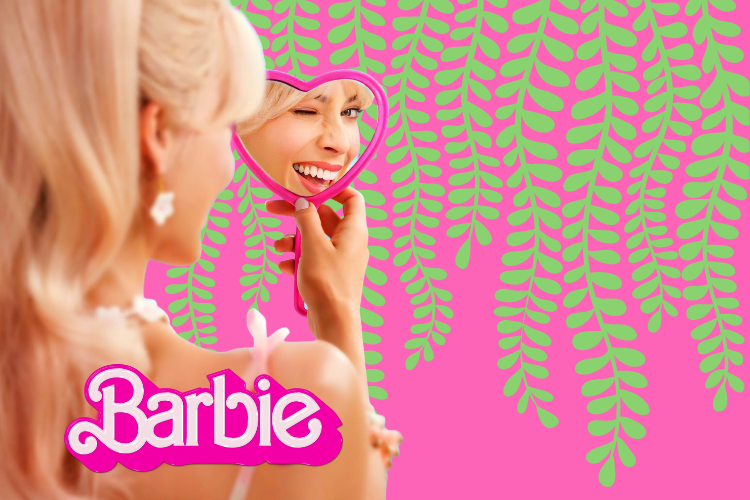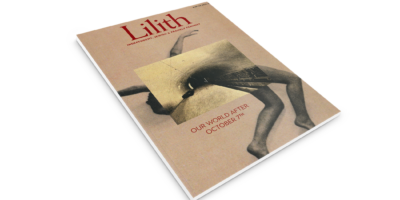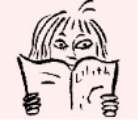
Did “Barbie” Give Us a New Lilith Midrash?
Growing up, I never got to see Barbie through a feminist lens. Barbie was pressed on me from the time I could toddle, and by the time I was old enough to begin forming my own opinions, I rebelled against her. This “perfect” doll had become a symbol of my girlhood repression in a place and family in which gender roles were strictly emphasized. It represented not having autonomy over my body, which my mother treated like that of a doll — never letting me cut my hair while I was under her roof because she wanted it long and princess-like and pressuring me to dye it with blonde highlights starting in my tweens. It represented her nitpicking and shaming my clothes when I didn’t let her choose them (tears were a regular part of going out anywhere). It represented the time I was around nine when, out of nowhere, she told me to suck in my stomach — in an embarrassed undertone, alerting me of the awkward social faux pas of being free in a girl’s body, even though no one but my grandmother was around.
Even when I tried to assert my own autonomy, I was relegated back to that doll-like prison of “perfect” femininity: For example, when I began to feel old for the hairbows my mother would clip in my hair before school every morning and refused to wear them anymore, my mother had an emotional meltdown and my father threatened to spank me if I stopped wearing them, just to get her to leave him alone.
I grew up surrounded by a culture in which anything outside of binary heterosexuality just didn’t really exist. It was about as much a possibility that one might be queer as it was a possibility for one to float down from the top story of her pink dream house in the morning. This being said, it wasn’t until my 20s that my queerness really began to poke up from under a dense layer of repression and into my consciousness — and not until my late 20s that I finally came out to myself first, then to those around me, as queer.
My mother believed that the most unimaginative stereotypes surrounding gay people were canon, and made a sport of accusing others of being gay behind their backs, a catty witch hunt of sorts. In my mother’s eyes, men who don’t date, broken hetero engagements, or being an unmarried woman of a certain age were evidence enough to make a case against a person’s heterosexuality. She undoubtedly recognized my queerness long before I did: As a young child, I always wanted to be the few women I saw on TV who were pretty butch (like Ralph Monroe from “Green Acres” reruns). I told my mother that I wanted tough, calloused hands and to be tall enough to look any man in the eye. I jumped to show off my physical strength and independence any opportunity I could, and vehemently abstained from even touching anything pink — a color that, like Barbie, represented the imprisonment of “girly” gender norms. I was proud to be a girl, but just wanted to be allowed to do the things all the boys were allowed to do, like have spitting contests outside, unabashedly enjoy catching lizards, and climb trees in comfortable, durable pants. The things I enjoyed frequently fell into the “not ladylike” category.
Looking back now, I can’t help but notice and wonder how my rebellion against gender norms and my mothers’ doubling-down to enforce them cycled together. Did I frighten my mother with my easy comfort in the blurry uncertainty of fifty shades of rainbow, rather than the controlled and defined world of pink versus blue?
By the time I was a teen, I had an eating disorder to keep up with the complex that had developed around my appearance. So much pressure and value had been placed on my looks for so long that I didn’t feel like anything more than a wrapper, or that I had anything else to offer beyond “pretty.” I became socially anxious (often paralyzed in social settings and stricken mute, trembling and sweating). My sense of self worth was placed on my body and looks, and — because no one can be completely perfect — I could never quite attain being “good enough,” despite obsessing over it to the point of exhaustion. I just wanted to be loved. If I couldn’t be thinner (despite already being thin and anorexic), I wouldn’t be loveable.
I maintained a flawless complexion, but it brought me no joy. (When I got my first zit as a tween, I distinctly remember my mother standing over me, squeezing it, and saying almost as if she were just thinking aloud “You can be the most beautiful person in the world, but if you have acne, no one will like you.”) My hair was complimented, but I could only see how much silkier it could have been. The more others gushed over how gorgeous I was (sometimes appraising me as if I weren’t there, like a prize-winning horse), the more my dysmorphic reflection seemed to warp and twist in the mirror. The Barbie-like person looking back at me didn’t look like me, and I would have trouble remembering what my face looked like as soon as I wasn’t looking at it.
As I progressed into my mid to late teens, I didn’t need my mother’s guidance on beauty much anymore. I religiously researched and kept up with all the latest beauty tips and trends (just as much as I pored over academic research papers about social sciences, because there was still a fragment of me trapped inside who was that weird lizard-loving tree climber who taught herself Latin in her tweens). I now dyed my own hair and highlights, applied self-tanner pretty expertly (as much as you could with the self tanner options of over a decade ago), and perfected the lusted-after “sexed up” hair style. I could utilize a pushup bra to my tactical advantage and knew to avoid high heels so I wouldn’t risk towering over any of the men around me (since I’m already 5’8″). I would often be the one to advise my mother on hair, make-up, and fashion at that point. Frankenstein’s monster had become Dr. Frankenstein.
I never realized something as simple as a plaything could become a talisman, a sort of magical poppet, for the repression and restricted-autonomy forced on me. Or that this small plastic idol had the power to curse me, inspiring me to wish away my own humanity in exchange for unaging plastic and perfect hair, in order to be loved and adored (even if only as an object, because what was love, anyway?). The doll should have been much heavier for all the weight that it carried.
However, while I was conflicted by the 2023 Barbie movie, it gave me a new perspective on what this doll could represent: Greta Gerwig’s film presents the history of Barbie as the doll that showed up in a barren landscape of girlhood, in which girls’ limited toy selection required them to play-pretend themselves as little mothers and wives. Barbie came on the scene as a fashionable career-minded adult woman — back in a time before women were allowed to have their own credit cards or cars without the permission of their husbands. Barbie was a toy who lived in her own world, and you could play with her whether or not you had a Ken doll. Her life wasn’t about marriage or children. It was about her independence and self-expression.
Perhaps, I realized sitting in front of the big screen, she and I actually had more in common than I’d realized before: Growing up, I dreamed of getting old enough to pay off my parents’ house and buy my own, of becoming a celebrated author and adopting numerous pets. I never had fantasies about my dream wedding or imagined walking down the aisle; I never dressed up as a bride and pretended to marry one of my stuffed animals, something that seemed a rite of passage for other girls. At times throughout my life, this unsettled me — I wondered if part of me was already broken, a factory defect straight out of the box. Unlike other little girls I knew, I had always envisioned myself as individual and independent, standing on my own — even when I sometimes imagined that I had children, I saw myself as the solitary head of house. Sure, Barbie’s physical proportions were the stuff of an anorexic’s fever dream, but I never before noticed how she has worked her way into the consciousness of girls and women over time, whispering like a friend telling you a secret on the playground: There’s more than one option.
Nonetheless, despite this progressive independence, she always remained trapped, to some extent, behind an painted smile and permanently sparkling blue eyes. Even though she offered a world of new possibilities to women everywhere, she still never got the chance to choose for herself. Until now. (Come back and finish this after you’ve seen the movie, if you don’t want significant spoilers beyond this point —)
At the end of the movie, Barbie gets a choice.
Watching this scene, I felt something stir within me: Ruth Handler (the real-life creator of Barbie, portrayed by Rhea Perlman) and Barbie herself stand alone in the Universe, one on one, and Barbie expresses that she wants to be more than just Barbie. At first, this scene reminded me of the Bereishit story of God creating humans — with Ruth, a Jewish mother, embodying God, and Barbie embodying the first human. But the analogy didn’t quite fit and kept eating at me even through the end credits. Finally, it snapped into place as I walked out of the theater into the sunlight: The moment felt more like a Lilith and God story than an Adam and Eve story.
Ruth (God) wants to make sure that Barbie (Lilith) fully understands what it means to become human. That it’s complex, uncomfortable, and uncertain. When Barbie accepts her personhood, even knowing the consequences, there’s a close up of her inhaling a first breath through her lips, her chest rising — reminiscent of God breathing into the nostrils of the humanoid figure It had molded from the earth (but in this case, molded from plastic). It almost felt like God freely offering Lilith the apple from the Tree of Knowledge, no strings attached, honoring her autonomy.
I love this imagined pre-Bereishit moment between God and Lilith, a new midrash that is tender, intimate, and vulnerable. It’s a parenthetical pause and inhale before Lilith embraces her own flawed humanity and steps into the human world, a world in which she will struggle under a patriarchal perspective for thousands of years to come. However, it’s a choice she makes, because she doesn’t want to be merely a perfect, infallible idea that’s always presentable and easy to package. She wants to be messy, real, and uncomfortable so she can contribute to a world that actually means something. Thus, she enters the world as a human, and then soon after leaves the (bright pink) Garden of Eden in search of her own place in the world.
This moment of dialogue between Ruth and Barbie in that scene stuck with me:
Barbie: “You’re my Creator, don’t you control me?”
Ruth: “Oh, Barbie — I can’t control you anymore than I can control my own daughter.”
Creator and creation, God and humankind, mother and daughter. Lilith is behind the scenes, whispering through Barbie’s pink lips into our psyches: “This is how things could be.”



